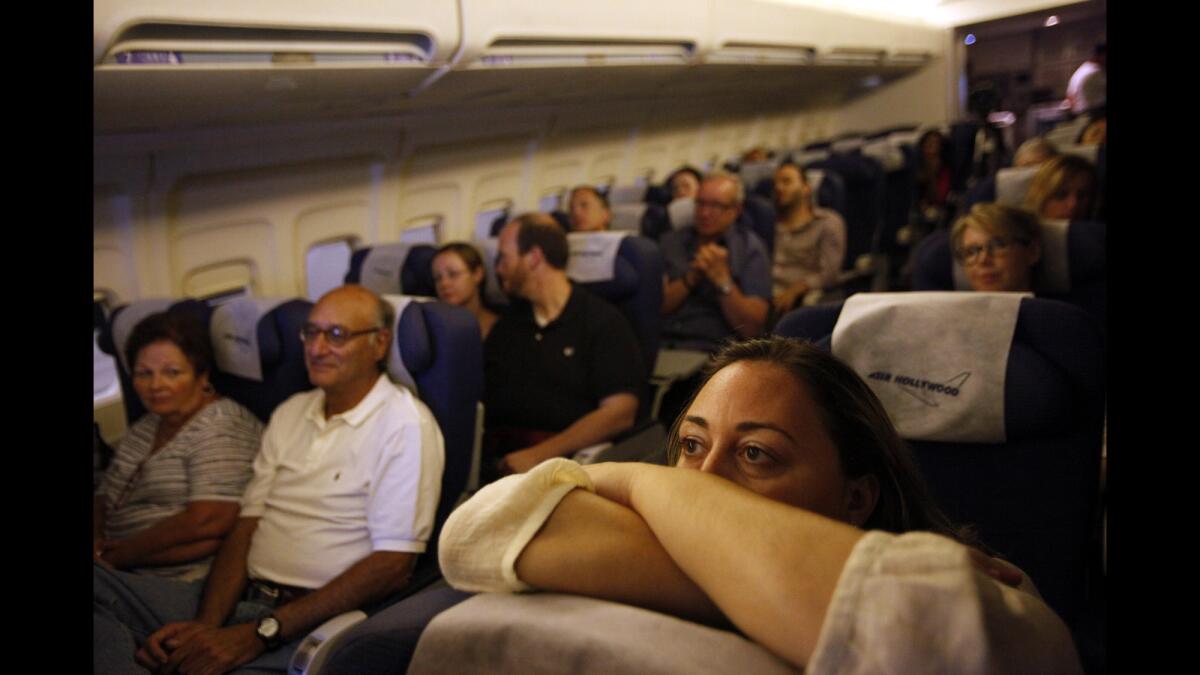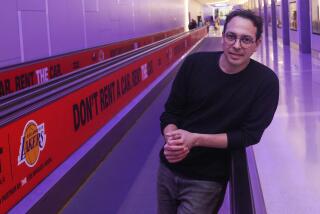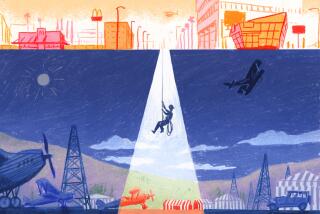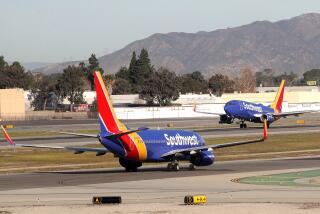Great Read: Film studio helps fearful fliers get off the ground

Anna Eliav, foreground, hasn’t visited her parents in Greece for four years due to her flying phobia.
As the passengers lined up to walk through an X-ray machine in the airport terminal, a surly security officer bellowed commands to the travelers.
“Empty your pockets,” she said. “Put all your items in the bin yourself. Take your shoes off.”
A few minutes later, the weary passengers walked down a jet bridge to board a Boeing 757. They settled into their seats, buckled up and prepared for takeoff as the jet engines rumbled.
Capt. Ron Nielsen, a self-described “hope merchant,” wasn’t in the cockpit. Instead, he was in the aisle holding a microphone.
“That’s the taxiing-out noise,” he said, explaining the dog-like bark of a hydraulic pump.
“What are you all thinking? Does this cause any trouble for anybody?”
Several hands shot up.
“I usually think, ‘Oh my God, why am here?’” passenger Andrea Gronwald said. “Why did I do this again?”
Gronwald and the passengers weren’t on an actual flight, and neither the aircraft nor the airport terminal was real. They were props ordinarily used to film some hair-raising aviation scenes in movies such as “Red Eye” and “Turbulence” or the TV series “Lost” at the Pacoima studio Air Hollywood.
But on a recent Saturday morning, the props were playing a very different role: a classroom for those suffering from an acute fear of flying.
“You’re not alone,” Nielsen, a retired US Airways pilot, assured the class. “We’re going to demystify fear of flying. There are no drugs, there are no secret pills. All you do is you give yourself one moment of peace without that pink elephant jumping out at you.”
::
Since its opening in 2001, Air Hollywood has become a go-to destination for filming aviation scenes in Hollywood. Its aircraft sets and props have been featured in countless TV shows, commercials and movies and not just for moments of terror. One of the more memorable scenes filmed at the studio was from the comedy “Bridesmaids,” when Kristen Wiig’s character has a pill-induced meltdown on a flight to Vegas.
Air Hollywood’s owner, Talaat Captan, launched the fear-of-flying classes this year, inspired by his own turbulent experience in the skies several years ago.
He was flying from New York to Tokyo when one of the engines on the 747 failed and the plane was forced to make an emergency landing in Anchorage in the middle of a bad storm. It took him years to force himself onto a plane again, he said.
Captan figured his studio — with its ersatz airport, four wide-body jets, 10,000-square-foot prop house and air turbulence simulator — could be the perfect environment to simulate a real-world aviation experience.
Billing itself as the “Safest Airline in the World,” Air Hollywood offers classes called “Open Sky for Autism” to help autistic children and their parents cope with the stress of flying. There’s also a K9 school that provides training for owners and their canine companions to fly with minimal stress. A postcard for the class shows two retriever puppies sitting in the cockpit.
Then there are Nielsen’s classes for adults. For Captan, the monthly classes — which cost about $200 and span two days — are partly altruistic and partly business. He sees the classes as way to serve a huge untapped market of fearful fliers who are desperate for help.
Some 60 million people are estimated to have some fear of flying. Half will not fly at all, or they find alternate means of travel, such as how legendary football coach John Madden switched to traveling by bus or train after a panic attack on a flight.
Others are “white knucklers,” who resort to medication and therapy to cope with symptoms that can range from sweaty palms and sleepless nights to anxiety attacks.
“I had all the symptoms you guys have,” Captan told the recent Saturday group. “I’m the one who knows how you guys feel because I’ve been there.”
Captan admits it’s an odd juxtaposition for a studio best known for simulating terrifying flight scenes.
“We scare people in one building and help them in the other,” he quipped.
::
The Saturday class drew a mix of about a dozen people: an elderly couple, a woman and her daughter, a single man and woman in their 30s. They all sat in black leather seats next to “Gate 7,” where an overhead announcement reminded them to have their boarding passes ready.
Standing next to a screen showing flight times and a giant blue-and-white mural of a jet, Nielsen shared his story. A former Vietnam Air Force pilot and veteran commercial pilot, he began coaching fearful fliers in the late 1980s after he heard about a psychologist who was treating patients for flight phobia.
Over the next three hours, he and three volunteer pilots and an air traffic controller talked about aircraft engineering, maintenance, flight communications and what’s behind all the unusual noises that can unhinge some passengers. They explained the physics of turbulence — air molecules bumping into one another like “speed bumps in the air” — and how pilots are trained to deal with it.
“It is the safest way to travel on the planet. Yeah, right,” Nielsen said, drawing nervous laughter from the class.
“It really is. It is safer than walking,” he added, explaining that an average of 7,000 pedestrians die each year in the United States and 35,000 to 40,000 die while driving on highways. By comparison, fatalities on major commercial flights in the U.S. are exceedingly rare: Three people died on a commercial flight last year when an Asiana Airlines plane crashed while landing in San Francisco.
Some of Nielsen’s teaching tools were decidedly low-tech. In a simple exercise to show how planes fly, he asked the “passengers” to make paper airplanes and hurl them across the room. Some of the planes sailed through the air because of their superior design, while others took a nose dive, prompting giggles.
Nielsen saw a teaching moment. “Even something as light as this paper — it’s not magic that it flies,” he said. “Airplanes fly not because of magic, but because they are designed to.”
Next, he handed out straws and instructed everyone to breathe into the tiny tubes to control their breathing before a flight and prevent hyperventilating, a major contributor to panic attacks.
To confront their anxieties, participants also took turns drawing pictures of themselves on giant sheets of white paper and listing their fears: turbulence, strange noises, mechanical failure, confinement, fear of heights and terrorism. One woman named Emma (she asked that her last name not be used) said her biggest fear was shame, recalling the time a paramedic had to take her off a plane after a panic attack. “It was so embarrassing,” she said.
On the simulated flight, the class experienced the sounds and sensations of taking off and landing, as well as sudden bumps and rocking intended to mimic light turbulence.
Nielsen showed a video explaining each sound and urged passengers to turn on their “harmonizer,” a hypnotic soundtrack of New Age music, poetry and voice-overs intended to distract them from any sudden noise that might trigger anxiety.
For Gronwald, a 40-year-old executive assistant from Glendale, the experience was remarkably real.
“These sets are pretty amazing,” said Gronwald, who hasn’t visited her family in Germany in years because of a bad experience with turbulence. “I’ve done virtual reality sessions in the past where you wear glasses, but this simulation was very real.”
The volunteer pilots and air traffic controller took turns answering questions and explaining their extensive training.
“It’s my way of giving back, and I love to watch the transformation of people who come into this class and get beyond their fear of flying,” said Rick Metler, a United Airlines pilot for nearly 40 years.
Metler and other pilots sat with participants during an actual flight that several of them took the following day to Sacramento. (The passengers paid for their own tickets.)
Jan Johns, a Maryland resident who recently moved to Los Angeles to pursue a career as a voice-over actress, said the flight to Sacramento marked the first time in a decade that she hadn’t been paralyzed by the usual symptoms — sweaty palms, shortness of breath, shaking and vomiting.
Johns and other classmates bonded and even talked about taking other flights together.
“I wouldn’t say I’m cured, but I feel like I have an awareness of my fear,” said Johns, 37. “There is power in a group of people that come together and help each other heal.”
Twitter: @rverrier
More to Read
Start your day right
Sign up for Essential California for news, features and recommendations from the L.A. Times and beyond in your inbox six days a week.
You may occasionally receive promotional content from the Los Angeles Times.







